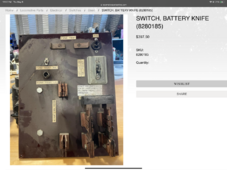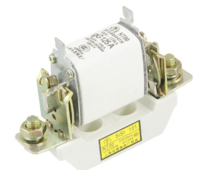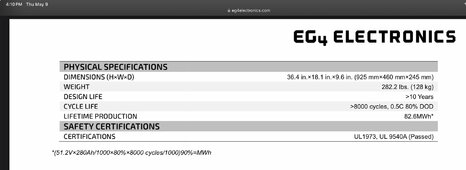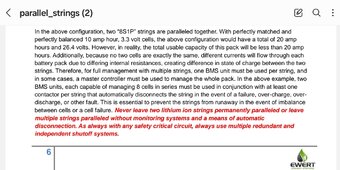Tulex
Solar Wizard
What's around the hot box is the concern. We can contain the fire inside the box, but if it's glowing red near flammable material, the outcome isn't good.
What's around the hot box is the concern. We can contain the fire inside the box, but if it's glowing red near flammable material, the outcome isn't good.
What's considered "high charge and discharge" currents?Batteries…
Modern vs Old
Why I considered these:
Cavet from Watts 24/7
“‘’’’’’
Through experience, we find that ANY battery chemistry, when cycled 100% every day with high charge and discharge currents has a limited lifespan, some LiFEPo4 batteries make it to about 3 months when worked hard
‘’’’’’’’
Quoted From link. 3 months hard use DAMAGED
He says 100% discharge. The guy at Watts 24/7 seems like smart guy to me - and is offering his experiences. He sells all kinds of batteries and equipment.What's considered "high charge and discharge" currents?

Sorry to hear your disaster. It has reminded me to keep class T fuses on every lifepo4 battery. So damn expensive though. Especially in the UK

you can keep them if you have a bms for each battery.It has reminded me to keep class T fuses on every lifepo4 battery.
The only logical reason to get more and more batteries is increased capacity. Unless person is on an ego trip with money to Burn.Quoted from an ad for a competing chemistry.
What is "Hard"? Well in excess of spec?
We expect LiFePO4 to tolerate 0.5C charge, 1C discharge, while kept at comfortable temperature. Isn't that the rate at which 6000 cycle life has been tested?
That would be 3 hours per cycle, 8 cycles per day, 2 calendar years to hit 6000 cycles (equivalent to 16 years cycled once per day.)
Others here do have a number of years use of their batteries, more likely charged around 1/8C and discharged 1/16C on average (daily use), with peaks well above that.


The Silicate batteries are interesting to potentially replace lead acid in below freezing conditions, both need to be only used to around 50% discharge for max life. Note in the listing it says "We parallel these with lithium batteries to give maxium surge capability" so maybe not as much current capability as LFP?He says 100% discharge. The guy at Watts 24/7 seems like smart guy to me - and is offering his experiences. He sells all kinds of batteries and equipment.
My past experiences are with aviation and than diesel electric freight locomotive power generation. We used lot of systems and subsystems to get it done. All sorts of variations.
We used 64vdc lead acid on diesel electric freight locomotives.
Knife switch to cut them in and out.
View attachment 214292
yeah I only work on conventional ships but the nukes are crazy anal about everything and with good reason. here at Yokosuka the US government flies in people from pugent sound naval shipyard to oversee and or sometimes perform repairs on the carrier. some of these fools are here for 3 or 4 months living in a hotel sucking up per diem like its koolaid in rural indianaThe only two things probably more critical and anal would be doing hot taps on gas lines and cooling lines for nuclear reactors.
Well of course I do. But what if the bms fails to interrupt a short circuit?you can keep them if you have a bms for each battery.
Then again, I also have my 7.7 Sunny Boys in there (along with the Sunny Islands) and most folks wouldn’t have big chonkin AC coupled line inverters.If one has or is building a sizeable system, a 20 foot connex would be much much better than those 10 ft variants. My power shed is 12x12 and I wish it were bigger. Granted a garage door takes up one side, and I have two sets of those smaller form factor wall mounted server racks in there too for my main coms room.
To expand, I’d need to get rid of the server racks and a little work bench that’s under them and/or frame in the garage door.
Yeah, you will never complain about too much space when your needs change. If you add 2" rockwool insulation then a container only nets you ~80-84" clear. I'd also suggest a door in the far end. A 20' container would let you put 7xEG4 14.3kWh batteries low and as many inverters above as you wanted, with AC distribution on the opposite wall.If one has or is building a sizeable system, a 20 foot connex would be much much better than those 10 ft variants. My power shed is 12x12 and I wish it were bigger. Granted a garage door takes up one side, and I have two sets of those smaller form factor wall mounted server racks in there too for my main coms room.
then you can nothing do.Well of course I do. But what if the bms fails to interrupt a short circuit?

I also have my 7.7 Sunny Boys in there (along with the Sunny Islands) and most folks wouldn’t have big chonkin AC coupled line inverters.

the fuse is not for disconnetion of the battery. it can be overcharged by current lower the trip current of the fuse.class t per string as the redundant backup?
i don't have the necessary experience at the storage levels the OP had, but for me, If i was using a batrium, or orion I would have a separate BMS that could disconnect each string, just like I do know. i would also have a separate class T fuse for each battery string... just like i do now. the one thing I will add to my system as a takeaway from this is a mechanical relay/contactor whatever you call it for each string and it will be controlled via the current BMS's vice using the BMS to control the current directly. it might burn a little juice but over the last three years everyone of us at one time or another has made the claim you need to de-rate Chinese electronics to be safe... a 100 amp BMS is only good for 60 amps etc. etc. I have always de-rated mine and my current DALY 150 amp units rarely see more than about 15 amps each in discharge and maybe 35 each in charging and i felt that was good enough. now I want a mechanical contactor to take up the strain instead. just feel better with it.Orion recommends multiple redundant and independent methods of disconnection, and a contactor per string, I see nothing about the design of a Batrium where the dangers of multiple strings without the means to disconnect those strings wouldn't also apply to it.
I guess in theory the contactor shutoff could be considered the primary method of disconnection per string with a class t per string as the redundant backup? Or use two separate BMS and contactors?
View attachment 214387


